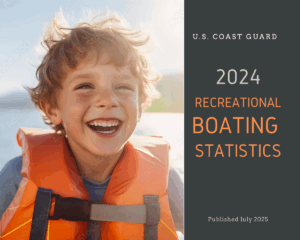
The U.S. Coast Guard Addendum to the United States National Search and Rescue Supplement, which is a supplement to the International Aeronautical and Maritime Search and Rescue Manual (IAMSAR) lists four key processes for the performance of search and rescue (SAR) missions:
- Distress Monitoring and Communications
- Search Planning
- Search Coordination
- Search and Rescue Operations
Both the National Distress and Response System (NDRS) and Global Maritime Distress & Safety System (GMDSS) provide coverage for boaters. NDRS is the primary distress alerting and SAR command, control and communications (C3) system for U.S. coastal waters (which extends from the territorial baseline out to 20 nautical miles). GMDSS is an internationally established distress and safety system.
If a boater is in distress (threatened by grave and imminent danger), they should contact search and rescue assets via VHF-DSC marine band radio, or with an EPIRB or PLB. It is the boater’s responsibility to contact search and rescue assets. A boater should always carry at least two communication devices that will work when wet. Please note, the U.S. Coast Guard does not endorse cellular phones as a primary means of distress notification in the maritime environment. Cell phones have several shortcomings in the maritime environment that can delay search and rescue authorities.
Process to Contact SAR via VHF-DSC Marine Band Radio (Channel 16)
1. Make sure radio is on
2. Select Channel 16
3. Press/Hold the transmit button
4. Speak slowly, and clearly say: MAYDAY, MAYDAY, MAYDAY
5. Give the following information:
- Vessel Name and/or Description
- Nature of Emergency
- Position and/or Location
- Number of People Aboard
6. Release the Transmit Button
7. Wait for 10 seconds – If no response, repeat “Mayday” call. If not in immediate danger, switch to CH 22 and follow the same steps as above, except do not use the word “MAYDAY.”
8. The U.S. Coast Guard will dispatch the closest, capable Search and Rescue (SAR) assets.
Process to Contact SAR via EPIRB or PLB
1. Distressed boater activates emergency locator beacon (EPIRB or PLB).
2. Beacon transmits a 406 MHz emergency message containing the boater’s Unique Identifier Number (UIN) to the LEOSAR (polar orbiting) and GEOSAR* (geostationary) satellite systems.
3. The satellites relay the 406 MHz emergency message to a ground station called the Local User Terminal (LUT). The LUT calculates the location of the signal by measuring the Doppler shift caused by the relative movement between the satellite and the beacon and forwards the location to the Mission Control Center (MCC).
4. The MCC continues to receive information from additional satellite passes and further refines the beacon position (2.3 nm search radius). An alert message is generated that is combined with the registration information from the database and is forwarded to the appropriate Rescue Coordination Center (RCC).
5. The RCC makes contact with the persons listed in the database to verify the existence of an emergency and gathers additional information about the beacon users. The RCC will dispatch the closest, capable Search and Rescue (SAR) assets.
6. Local SAR assets launch a rescue mission and use the 121.5 MHz homing signal to pinpoint the beacon.
*On average, worldwide, this distress notification (steps 2 through 5) takes up to one hour for non-GPS beacons. For self-locating beacons that provide GPS position data in their first transmissions, the search radius is reduced to .05 nm (100 m) and the notification can take as little as three minutes. (Data provided by Cospas-Sarsat.)
More Information



